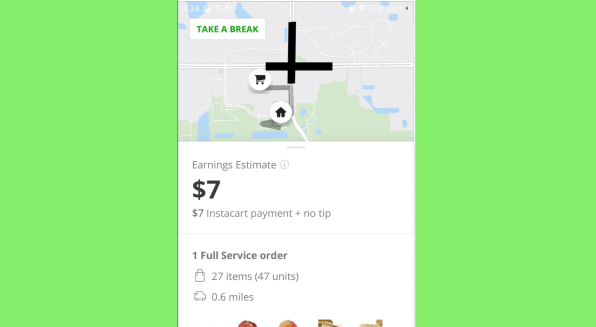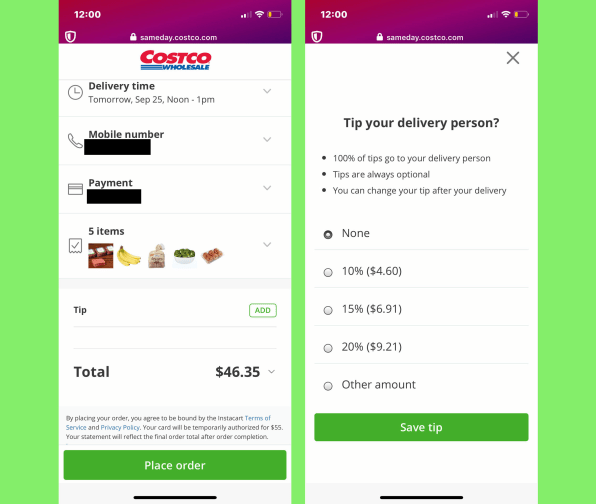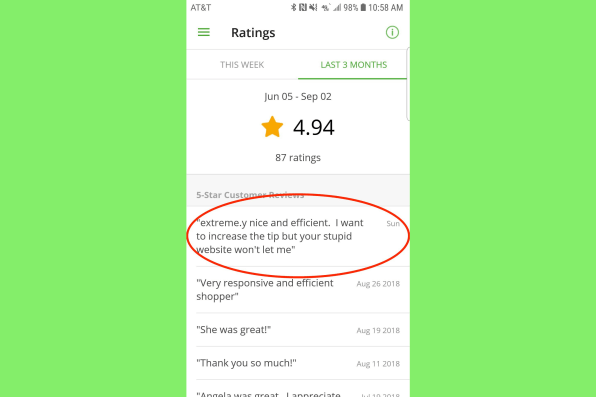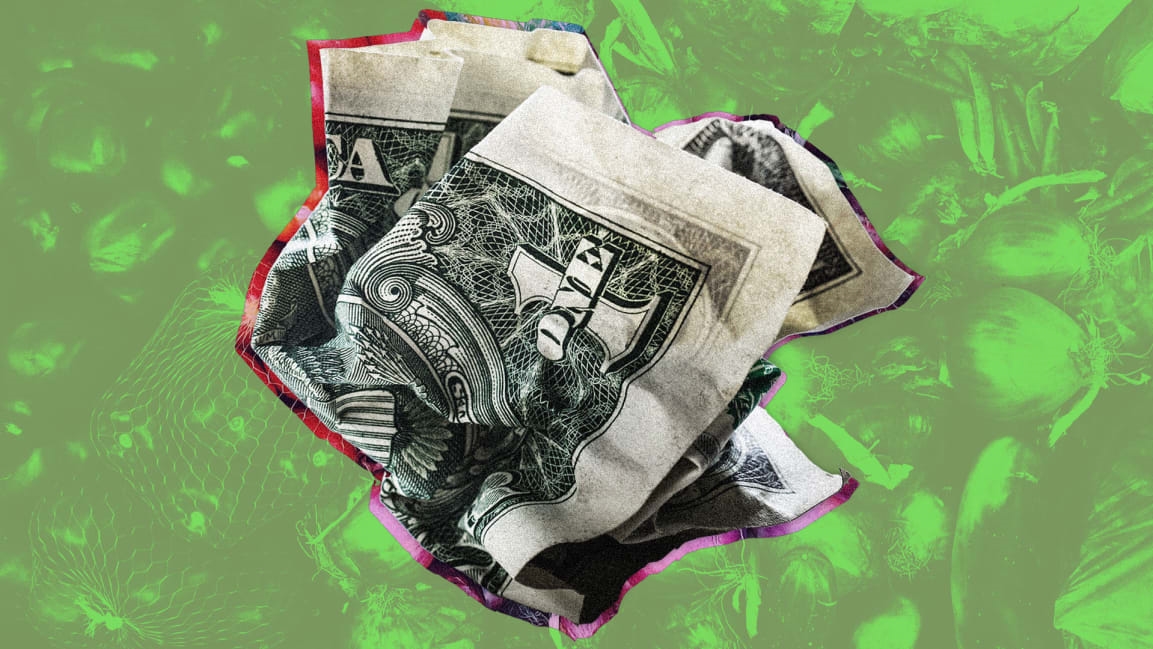Terrible tippers are making underpaid delivery jobs even worse
Amanda Jenerou wanted to supplement income from the tattoo shop she and her husband own near Phoenix. So in November 2018, she signed up for a freelance gig with grocery-delivery service Instacart. While the money initially beat out minimum wage jobs, Jenerou started noticing some disturbing trends: lower pay from Instacart, lower tips from customers, and some customers dangling tips that they deleted after she’s completed the delivery.
“I delivered to one woman three times and every time she took away her $2 tip,” says Jenerou, whose customer ratings have always hovered between 4.97 and five stars. “I purchased everything the customer wanted and made sure the customer was happy with the purchases.”
App-summoned deliveries from companies like Instacart, Amazon, and DoorDash have made our lives very convenient—but at a price. “Customers [are] getting sticker shock when they see the final total,” says Sarah, a Silicon Valley-based Instacart delivery person who asked that we publish only her first name. “Thirty-five dollars worth of groceries can easily become $60” when fees and tip are added in, she says.

It’s enough to make customers regret the expense and wish they could take it back—which they can, to an extent. Several delivery services offer the ability to change or remove a tip that’s already been set in the app. Instacart, a pre-IPO unicorn valued at $7.87 billion according to research firm PitchBook, allows consumers to adjust their tips up to three days after delivery. “The tip is the one thing you can take away,” says Sarah, who’s averaged a 4.92 star rating.
But for gig workers, tips have become a lifeline. Workers claim that companies like Instacart, striving to make a return for investors, have started lowering payments. And for consumers, there are few norms around what you should tip delivery people—leaving some to default to the low (or zero) tips that delivery apps suggest, or even delete their tips after the fact.
Lower pay combined with lower tips
Amanda Jenerou and Sarah are among over a dozen people complaining of deteriorating pay conditions in national Facebook and Reddit groups where Instacart’s freelance delivery workers, known as shoppers, trade war stories. In recent months, there have been more examples of declining base pay from Instacart. In the past, customer tips helped make low-paid assignments worthwhile, but shoppers also complain of more gigs with low tips, zero tips, or disappearing tips. Even shoppers with five-star customer ratings have seen their tips reduced.
Take, for instance, a 27-product, 3.9-mile delivery posted to the Facebook group. The job initially offered $15.57, including tip. But when the consumer removed the tip after receiving their delivery, the shopper wound up getting $10.36. That’s especially tight, considering that shoppers have to cover the cost of fueling, maintaining, and insuring their vehicles. They don’t get benefits, and they pay twice the payroll taxes that employees would.
Jenerou and other shoppers I spoke to suspect that customers are gaming the system. As freelancers, shoppers aren’t bound to accept an assignment, but customers who offer generous tips may entice a shopper to take the job. Having secured a speedy delivery, the customer could then slash the tip. However, no shoppers have furnished a smoking gun, such as customers who admit to switcheroos, or displayed evidence that Instacart encourages the practice.
Instacart refused to comment on whether customers may be dangling tips in front of hardworking shoppers and then deleting them. Instacart says that, in general, tips are optional and tip removals are rare, occurring in less than 1% of orders. The company declined to say how many orders occur in total, but says it has more than 130,000 shoppers in North America.
There are some other explanations for disappearing tips: customers could be reducing the tip due to poor service, and even shoppers concede that some in their ranks mess up orders. But customers don’t have to prove something went wrong in order to change a tip, so it’s impossible to say.
I spoke to shoppers who have never experienced zeroed-out tips, but it’s happened enough that some shoppers suspect a second cause beyond cheapskate customers: a bug in Instacart’s app that inadvertently deletes tips. Instacart says that no such bug has ever existed. If a tip is removed, they say, it was the customer’s decision.
Regardless how common, deleted tips strike a nerve with shoppers who say they’ve been seeing more low- and zero-tip offers overall. “Most orders I get offered have $0 tips. This has been getting worse in the last few months,” says Jenerou. Instacart won’t say what percentage of customers leave a tip, or the average amount. Customers can also tip in cash, which doesn’t show up in the app or Instacart’s records. (Some shoppers report getting generous cash tips, while others report getting none.)
Claims of lower tips come on top of shopper complaints of lower pay from Instacart itself for assignments, known as batches. “I have noticed a dramatic decrease in not just tips, but batch offers overall, in the last three to four months,” says Samantha, an Ohio-based Instacart shopper with a 4.97 rating who asked that we use only her first name.
The Wild West of tipping
The tension between shoppers and Instacart reflects stress across the gig economy. Despite multibillion-dollar valuations, many of these companies aren’t turning a profit. (It’s unclear whether Instacart is profitable.)
In the beginning, flush with venture capital funding, gig economy companies like Instacart and Uber paid well and charged little in order to entice workers and customers and build market share.
Now these companies have to show potential investors that they can make money. Barring efficiency miracles, that means keeping pay low and shifting the burden to customers to make up the difference with tips. But these are the very customers who may be feeling sticker shock and want to spend less overall.
Nor do customers have a clear idea how much workers depend on tips, as they might with restaurant servers. “With these delivery services, it’s kinda like the Wild West. And it matters what the app is nudging the customer toward, more than what is common etiquette,” says Harry Campbell, a former Lyft and Uber driver who runs The Rideshare Guy blog.

Instacart shoppers I spoke to accuse the company of nudging customers toward low tips. Instacart is adamant that tips are optional (which the platform actively reminds its users on ordering screens). However, Instacart does have default gratuities, in its app and on the websites for major retailers such as Kroger, Lucky, and Publix, typically set at 5% or $2. Many gig companies have defaults set to zero.
“I just wish Instacart/Kroger would change that default tip to 15%,” says Samantha. “If I went to a restaurant, I wouldn’t tip my server 5%.”
“On $100 orders, that’s $5,” says Campbell. “And $100 of groceries is a lot of work.”
Instacart partner stores can set their own default tip. On Costco’s ordering page (described as “Powered by Instacart”), the tip has long been set to zero. Customers have to click through to another screen to change it.
“I do believe Instacart has made the app difficult to navigate in the way of tips,” says Jenerou. “When something is not easy, we have a tendency of ignoring it.”
Some shoppers are now ramping up the pressure. They are calling for a work slowdown protest from November 3-5 to demand that Instacart increase its default tip from 5% to 10%.
Tips make it worthwhile
Tips are a sensitive topic for Instacart. Earlier this year, shoppers protested the company’s practice of counting tips toward its claim that national pay for shoppers averages “above $15 per hour of work.” In February, Instacart bowed to pressure by instituting minimum fees of $5 to $10, depending on the assignment and city, but regardless of tip amount.
Large orders can pay much more, but shoppers and advocates claim that Instacart is deliberately undervaluing assignments—making some no longer worth doing without a tip. In April, labor rights group Working Washington analyzed over 900 Instacart batches and calculated an average pay of $7.66 per hour—after subtracting tips, vehicle expenses, and the extra payroll taxes freelancers pay.

Tips should be even higher for grocery delivery than other jobs, says Jake Kronborg, a gig worker who covers the industry on his YouTube channel. Extra stresses include navigating crowded stores, adjusting orders due to out-of-stock items, and lugging many bags up several flights of stairs. “On grocery delivery, I would be tipping 20% to 25%,” he says.
The numbers no longer add up for Jenerou. She rarely takes Instacart assignments now and has instead been working for other companies, such as delivery service Amazon Flex, where she says she can “make a livable wage.”
“I really did love shopping for others,” says Jenerou of her early days with Instacart. But that soured in less than a year as she watched her pay drop. “I actually noticed it starting to crush my morale with the company.”
Contact me with tips on Instacart or any other topic at seanjcaptain@gmail.com or encrypted at seanjcaptain@protonmail.com, or reach out on Twitter or Facebook.
(102)



